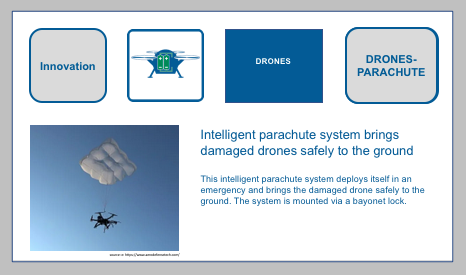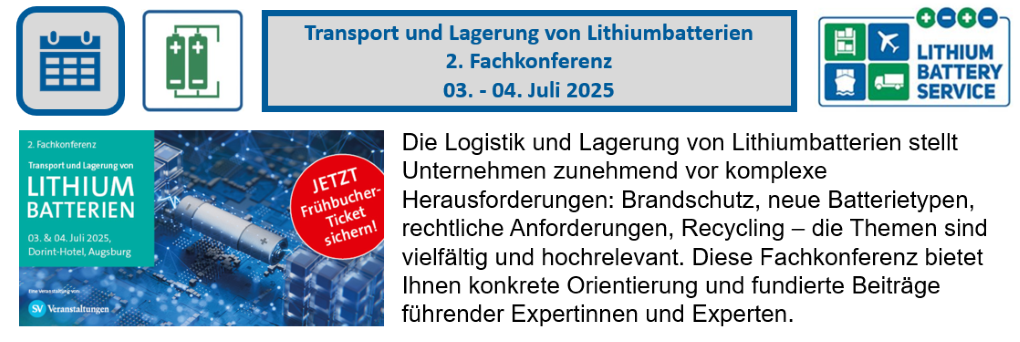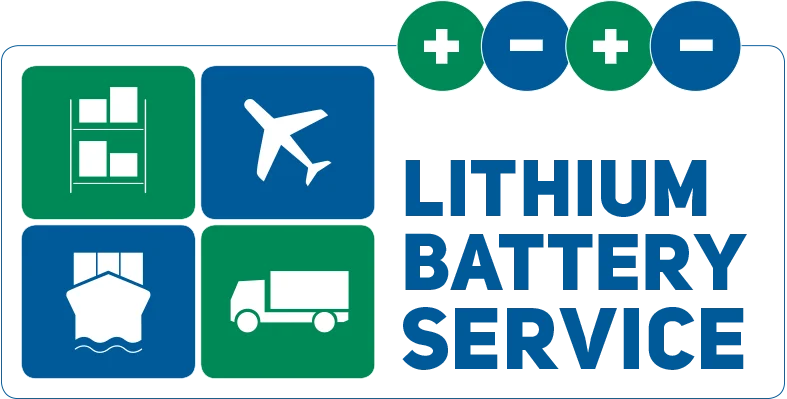Drone and Multicopter Rescue with Smart Parachutes
Drone and Multicopter Rescue with Smart Parachutes. This intelligent parachute system deploys itself in an emergency and brings the damaged drone safely to the ground. The system is mounted via a bayonet lock.

Drone and Multicopter Rescue with Smart Parachutes
The SAE newsletter dated 16th November 2020 referred to a very interesting article which has been published on the website of Aerospace & Defence:
https://www.aerodefensetech.com/component/content/article/adt/insiders/aerospace/stories/38103?utm_source=SAE_Aero_News&utm_medium=email&utm_campaign=20201116&oly_enc_id=5467D7085134G8Y
This intelligent parachute system deploys itself in an emergency and brings the damaged drone safely to the ground. The system is mounted via a bayonet lock.
Its integrated intelligent electronics monitor the flight conditions completely independent of flight control. Included is an algorithm that implements an automatic crash detection.
In case of an emergency the drone pilot does not need to react and press a release button himself/herself anymore because the system operates automatically and swiftly.
Extremely light varieties of the system work with a catapult mechanism for release.
There are also varieties which, in order to obtain a very quick release reaction, use explosive pyrotechnical substances.
There are quite a few companies which use such parachute systems designed for drone and multicopter rescue. Here are some examples. The parachute systems they offer are of great diversity. It’s worthwhile comparing services and prices.
The DRONE RESCUE SYSTEMS company for instance is located in Graz, Austria. Here’s the link to their website:
https://dronerescue.com/
The Opale Aero System SARL company has its headquarters in Marquise, France (https://www.opale-parachutes.com/de/)
The AltiGator Unmanned Solutions company with headquarters in Waterloo in Belgium also offers different system solutions:
https://altigator.com/drones-contact-uav-rpas/
You also find further information provided by the Association for Unmanned Aviation:
https://www.uavdach.org/?p=1304293
Requirements for the transportation of drones and multicopters
For all owners and users of drones and multicopters we would now like to provide important product and logistics information.
Most drones are powered by lithium ion batteries. There are strict legal regulations for these lithium ion batteries in order to ensure safety during their use and transport.
Often, somewhere in the drone or in the multicopter, lithium metal cells, too, are additionally built into the electronics.
For all lithium cells and lithium batteries applies:
1. They must all be manufactured according to the Quality Management Program described in the Transport Regulations.
You’ll find more precise information about what is included in this Quality Management Program for the manufacture of lithium cells and lithium batteries under the following link:
https://www.lithium-batterie-service.de/en/quality-management-program
2. All series products must have successfully passed the UN test series 38.3 of the UN Manual of Tests and Criteria.
We have described here to what extent the products are being tested there:
https://www.lithium-batterie-service.de/en/un-38.3-test-series
As of 1 January 2020, every manufacturer and subsequent distributor or seller must, if requested, provide a UN 38.3 test results summary for every lithium cell and every lithium battery.
Already before purchasing a drone or a spare lithium ion battery, we strongly recommend you to obtain all logistics data from the manufacturer, respectively from the supplier.
The easiest way to do so is to use our free-of-charge supplier check list, which also checks all information required by the UN 38.3 test results summary. We have drawn up one list for lithium cells and one for lithium batteries. You can download them free of charge in German and English under the following link:
https://www.lithium-batterie-service.de/en/downloads-guest
3. For lithium ion batteries with an energy/Watt-hour rating exceeding 100 Wh, before transport the following technical requirements must be fulfilled:
- Each battery must be equipped with a protective device against internal excess pressure or must be laid out in such a way that forced breaking is prevented under normal transport conditions.
- Each battery must be equipped with an effective protective device so as to prevent shortcuts.
- Each battery with a parallel connection of cells or with a parallel connection of series of cells must be equipped with effective devices which prevent a hazardous return current (e.g. diodes, fuses and so on).
We provide checklist articles for the transport of all varieties of lithium cells and lithium batteries in conformity with the Regulations.
For the shipment of a drone/a multicopter with a big lithium ion battery exceeding 100 Wh in Road Transport according to ADR, our checklist article LIBS-46-DE would be the right choice:
https://www.lithium-batterie-service.de/en/checklist-46
Transport in a company vehicle – The Craft Business Regulation
There are also clear regulations for carrying such drones/multicopters in a company vehicle. This is allowed only under the conditions of the so-called “Craft Business Regulation”. That means: only for the purpose of using the drone or the multicopter in the performance of one’s own main professional activity, e.g. in order to perform a test at the client’s, or as a sample destined for the client, or for the use in surveillances, for taking photographs or for video recordings.
A free checklist, to check if these conditions apply to you, you find here:
https://www.lithium-batterie-service.de/media/pdf/bb/8c/4c/EN-Craft-Businesses-Checklist-Lithium-Battery-Service-2017.pdf
Drone with accident – defective/damaged lithium ion battery
If your drone has been damaged and it cannot be excluded that its built-in lithium ion battery has been damaged, too, a hazard assessment is to be made before transportation in order to decide if a safety-critical hazard may arise from the lithium ion battery during transport.
A drone that has had an accident and with a defective/damaged lithium ion battery must not be carried anymore in a company vehicle according to the Craft Business Regulation. Instead, it requires mandatory packing, marking and labeling as “defective/damaged” in conformity with the Regulations. A transport declaration must be issued.
If your sales representatives shall be assigned to transport drones with defective/damaged lithium ion batteries, they require to be given the respective instructions according to 1.3 ADR, and a 2-kg fire extinguisher must be in the vehicle.
If there is a safety-critical defect of the lithium ion battery, an appropriate packaging becomes necessary. Furthermore, it may only be transported by a driver who has an ADR license because now transport category 0 applies and orange warning signs must be opened at the vehicle.
For this special case, too, we provide the proper checklist article LIBS-54-DE for you, so that you can easily check the correctness of your internal company processes:
https://www.lithium-batterie-service.de/en/checklist-54
Do you require a skilled, competent person who can assess if there is a defect/a damage and whether this may bear safety-critical effects or not?
Or would you like to set up an assessment questionnaire for the employees of your returned purchases department so that they can assess the hazard potential of your products?
Do you have questions regarding the shipment of lithium cells and lithium batteries?
Don’t hesitate to contact us under:
https://www.lithium-batterie-service.de/en/contact/consulting
We’ll be pleased to help you.












